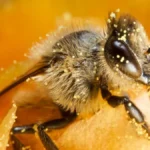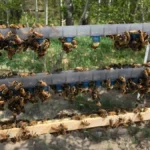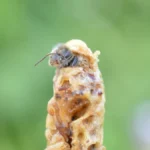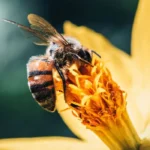What does a honey bee eat? Pollen, nectar, fungus spores, cow food, flour, brood, fruit, rubbish, anal secretions of insects, and a lot of other weird things! Let us take a closer look at this interesting question.
What Does A Honey Bee Eat?
The technically correct answer for this goes like this. In the early larval stages, honeybee larvae eat Royal Jelly – this is a food secreted by nurse bees. So let us start looking at this first food and then we will look a the other after that.
Bee Food #1: Royal Jelly
This is a superfood. For bees, a diet consisting of royal jelly for the entire larval stage will cause a female egg to grow into a big, reproductively capable queen bee. Workers receive less royal jelly and switch over to a pollen diet after a few days (varies depending on race).
Royal jelly consists of 50-60% water, about 18% protein, around 15% carbohydrates, 3-6% lipids (fats), 1.5% mineral salts, and various essential vitamins. This is basically the bee equivalent of mammal milk – it is a secreted nutritionally complete food that allows young bees to grow very fast.
To put this in perspective, cat food contains about 26% protein, and dog food about 18% protein. If you were very wealthy, you could probably safely rear and maintain your dog on a diet of royal jelly. This is how complete the food is.
Bee Food #2: Pollen
Pollen is collected from flowers by bees. It is a rich and variable source of proteins, lipids, vitamins, and minerals. On average it apparently contains about 22-23% protein. This is nearly the same as a good steak. Pollen also contains minerals, lipids, carbohydrates, vitamins, and various other phytochemicals.
Pollen is gathered from flowers, and as we know, flowers vary a lot depending on what plant they are on. Some pollen is actually devoid of certain nutrients and you will find that if the bees work such plants for long periods of time they can become weak/ill/die. The article in the link also shows that in a situation where bees work on a single pollen source, the likelihood of nutritional problems increases. Healthy bees are more likely to occur on diverse pollen diets.
Bee Food #3: Nectar
Nectar is the sugar solution flowers product to attract bees. It can contain variable concentrations of sugar dissolved in water, amino acids, as well as trace elements, vitamins, and certain phytochemicals. Sugar concentration can vary from 20% to 65% in some cases. Generally, work on a sugar concentration of 50-65% is the most attractive to honeybees.
Bees can consume nectar straight from the flower as an energy source. Nectar is also consumed in the hive as an energy source by all the bees.
Bee Food #4: Honey
Bees can dilute honey with water and consume this. Once diluted it is the same as nectar.
Other Things Bees Eat
Bees are quite adventurous with eating things. Although they are technically pollinators that collect pollen and nectar from flowers, they can bend these rules a bit and harness other sources of sugar and protein.
Bee Food #5: Powders and Spores
During periods of lower pollen availability, bees can be quite creative. I have seen bees collecting spores from mushrooms. In the Congo (DRC) and Mozambique, street-side vendors sell spices such as chili, turmeric, and curry on the side of the road. I have seen bees collecting chili powder and taking this back to hives.
Bees will sometimes collect animal feed powders during nectar dearths. This can be a problem if your bees are near a feedlot as it tends to worry the cows when they eat a bee by mistake. I have also had problems with bees collecting chicken feed (they love broiler starter mash as it has quite high protein).
What does a honey bee eat? Chili! Bees collecting chili powder in Mozambique.
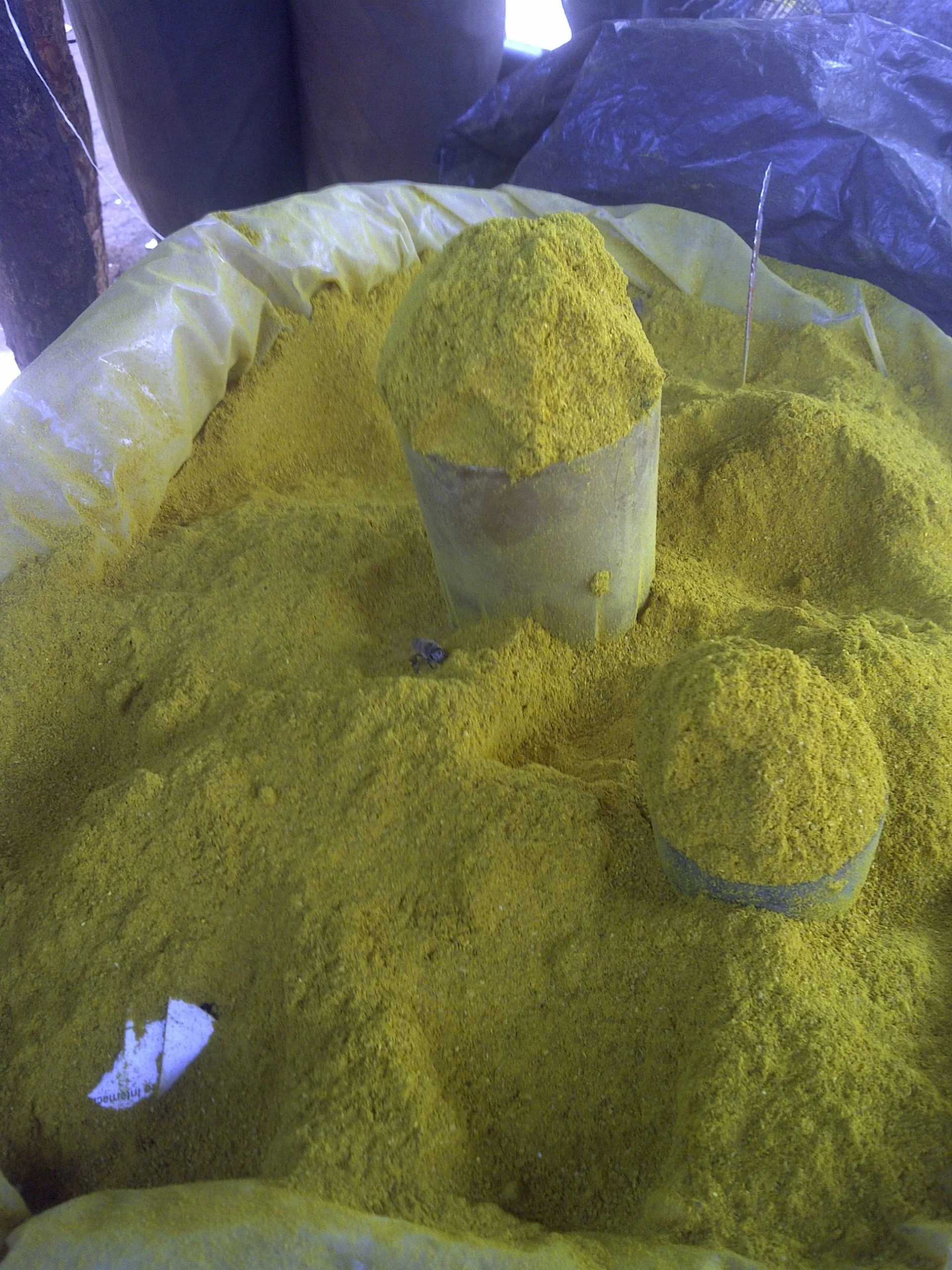
What does a honey bee eat? Ginger powder? Here they are collecting ginger powder in the Congo.
Bee Food #6: Insect Exudates
Certain sap-sucking insects suck sugars out of plants. They use their biting mouthparts to pierce the phloem vessels in the plant. These vessels contain the sugars the plant is producing through photosynthesis.
If the insect (eg an aphid) hits the main phloem line with high pressure, it can end up getting overfilled and will leak a bit of sugar solution from its anus. Bees find this, and within no time they learn to go to aphids and give them a little squeeze -that aphid then exudes a drop.
This nectar is termed honeydew, and honeydew or “dark forest” honey is prized for its strong taste and medicinal properties. I once produced a few supers of this stuff when I had bees near a pine tree forest. The honey was dark and tasted like turpentine! Generally, honey such as Black Forest honey from Germany tastes a lot nicer than the stuff I produced.
Do Honey Bees Eat Fruit?
When asking what does a honey bee eat? Fruit would probably be an answer you would not expect. I have however often seen bees eating fruit. When wine and table grapes ripen they will often reach sugar contents that are attractive to the bees. The bees will then bite holes in the grapes and suck grape juice out of the holes.
I have seen bees doing similar things with date palms in areas where these are grown near vineyards. It appears that bees can learn to collect nectar from dates. I have seen bees collect the juice from a pineapple factory, and have also seen them collecting fruit sugars from overripe pears. I have never seen a bee show any interest in apples and peaches.
Do Bees Eat Their Own Honey?
Yes – that is why they store it. When I lecture about bees and get asked “what does a honey bee eat?” I have often noticed that people are surprised that bees eat honey. They do not produce honey for us in fact.
As beekeepers, we help them produce more honey than they need, and then our management fee for this is to take some of the honey. They are however completely unaware that this relationship exists. Bees are generally really upset when they discover we are taking their honey – this is why we use smoke to disguise our “theft” from them.
Bees store honey like we store money in the bank. It is a store of energy that can be used in the future. Honey reserves are the beehive’s savings. They dilute honey with water and eat this. We sometimes have to help them out with some sugar.
Do Bees Eat Other Insects?
What does a honey bee eat? Insects? The official answer is no. Much like my vegetarian friend who does not eat meat – but who occasionally eats a burger if nobody is watching – honeybees are also “vegetarian”.
Technically their protein source is pollen, but I have actually seen a bee eating aphids on a branch once – it was interesting to watch. This was during a strong Eucalyptus honey flow – I never identified the type of Eucalyptus, but it produces no pollen. The hives work like crazy and get pollen starved. There were some citrus trees covered in aphids and I saw a honeybee chewing these aphids up. Maybe it was eating honeydew, but that aphid was not there when it was finished.
The Honey Bee Diet
Also read: pH Levels of Honey: Top Uses and Ultimate Health Benefits
Bees eat pollen, nectar, and honey. They also will eat sugar solutions that they extract from fruit and insects, and they can get creative in terms of eating powders that have protein in them. Bees, like us, thrive on a diverse diet – if they are eating just one type of pollen, they can get sick. For healthy bees, diverse flowers help. So get planting those wildflowers! The bees need them. If somebody asks you “What does a honey bee eat?” you can now answer and tell them some funny things that will make them look at you a bit strangely. Bees even eat magic mushroom pollen – I have seen it. Naughty creatures. If you enjoyed this please share.
Read more about: What Eats Bees In The Food Chain
Honey Bee Diet FAQs
What is the main food source for honey bees?
Honey bees primarily feed on nectar and pollen. Nectar provides them with energy through its sugar content, while pollen offers essential proteins, fats, and other nutrients needed for growth and development.
Do honey bees eat their own honey?
Yes, honey bees consume the honey they produce. Honey acts as a stored energy reserve, especially during times when nectar sources are scarce, like in winter.
What is royal jelly, and do all bees eat it?
Royal jelly is a nutrient-rich secretion made by nurse bees. It’s fed to all bee larvae initially, but only queen larvae continue to consume it throughout their development, which allows them to grow larger and become reproductively capable.
Do honey bees eat fruit?
Yes, honey bees sometimes consume fruit. They are attracted to ripe fruits like grapes, dates, and pears, from which they extract juice for its sugar content.
Can honey bees eat other insects?
Though honey bees are mostly vegetarian, they may occasionally feed on insect exudates like honeydew or, in rare cases, even chew on small insects such as aphids during periods of nutritional stress.
What unusual things have been observed in a honey bee’s diet?
Honey bees are known to eat unusual items like chili powder, ginger, and mushroom spores. They have also been seen collecting protein-rich powders such as chicken feed during times of pollen scarcity.
Do honey bees eat pollen exclusively for protein?
Yes, pollen is the main source of protein for honey bees, but they may supplement their diet with other protein-rich sources like animal feed or fungus spores during dearth periods.
What is honeydew, and do bees eat it?
Honeydew is a sugar-rich substance secreted by sap-sucking insects like aphids. Honey bees collect honeydew and use it to make a dark, flavorful type of honey, often prized for its unique taste.
Do honey bees ever eat flour or other powdered substances?
Yes, bees may collect powders like flour or feed from livestock, especially during times when pollen is scarce. They do this to fulfill their protein needs when natural pollen sources are unavailable.
Can honey bees eat mushrooms?
Yes, honey bees have been observed collecting spores from mushrooms. Though this behavior is uncommon, it highlights their adaptability in sourcing nutrients.

Dr. Garth A. Cambray is a Canadian/South African entrepreneur and beekeeper with 28 years of experience in apiculture and specializes in adding value to honey. His Ph.D. research developed a new advanced continuous fermentation method for making mead that has resulted in a number of companies globally being able to access markets for mead. His company, Makana Meadery, exports honey mead to the USA where it is available to discerning connoisseurs. He has also developed technologies to commercially manufacture organic honey vinegar in Zambia for export globally. He holds a few patents globally in the ethanol industry and believes in technology and knowledge transfer for human development and environmental sustainability. One of his proudest achievements is the fact that the wind farm he started at one of his old apiary sites has essentially made his hometown carbon neutral.



